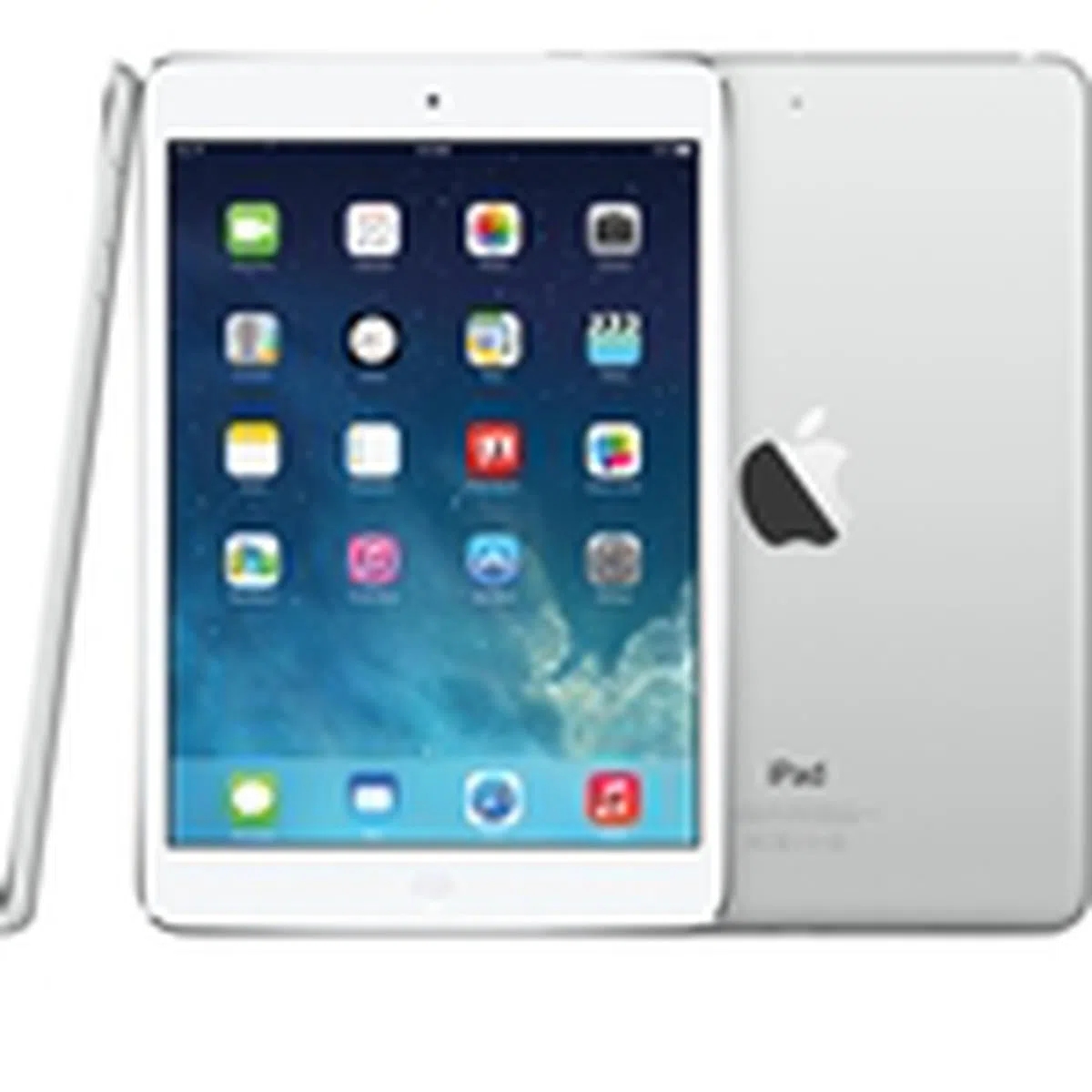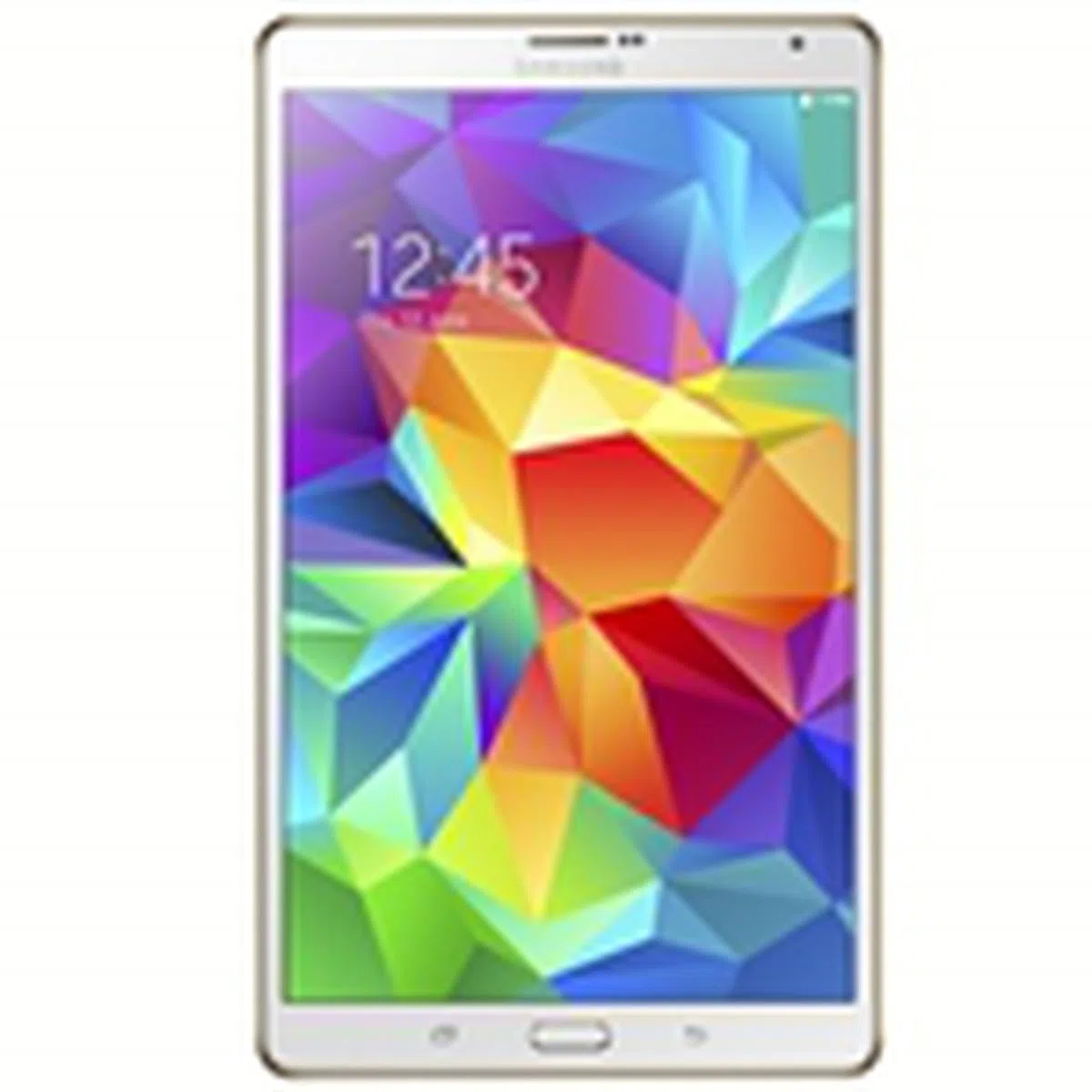Shootout: Apple iPad Mini vs. LG G Tablet 8.3 vs. Samsung Galaxy Tab S 8.4
The 8-inch tablet space is growing in popularity due to their ample screen real estate and portability. We pit three of the best 8-inch tablets in the market - the Apple iPad Mini with Retina Display, the LG G Tablet 8.3 and Samsung Galaxy Tab S 8.4 - and see which one is an all-round performer.
A Move Towards 8-Inch Tablets
While the modern day tablet industry started out with 7-inch and 10-inch variants, the increasing adoption of phablet devices, which typically have screen sizes ranging from 5.5 to 6.44-inches, and the fact that 7-inch tablets don't offer enough screen real estate space have kick started the rise of 8-inch tablets. In fact, they are steadily gaining traction as they provide a fine balance between screen real estate and portability. For the most part, 10-inch tablets are great for media consumption and entertainment, but their size makes them less portable and unwieldy to manage for comfortable on the go usage.
If you are looking around for a high-end 8-inch tablet, there are currently three notable models in the market: the Apple iPad Mini with Retina Display, the LG G Tablet 8.3 and Samsung Galaxy Tab S 8.4. Similar to our recent high-end 10-inch tablet shootout we've conducted, we will put these 8-inch slates in various usage scenarios to highlight their strengths and weakness. Before we dive into the shootout, here's a look at the specifications of the three tablets:
Reading
The 8-inch form factor makes the three devices excellent for reading; there is ample real screen estate for reading and the devices are generally light enough to hold in the hand for long periods of time.
We've explored the readability and availability of reading content in our previous 10-inch tablet shootout, where our nod goes to the Apple camp (which doesn't really change when considering the smaller tablets), we've chosen to add another aspect in this article: readability of magazines. Since Zinio is supported on both Android and iOS platforms, we will use our HWM magazine as an example:

From left to right: Apple iPad Mini with Retina Display, Samsung Galaxy Tab S 8.4 and LG G Tablet 8.3
Since most magazines including ours are laid out in 4:3 aspect ratio format, reading them will be more natural and optimal on the Apple iPad Mini. In addition, the font size is also larger, making it easier to read without zooming in on a particular section. The on-screen navigation buttons on the LG G Tablet 8.3 also take up some screen real estate, making it harder to read.
Music
There are consumers who use tablets, especially the 7 to 8-inch form factors, for listening to music as they are more portable than the 10-inch counterparts. In this section, we look at the availability of music content and the features of the default music player on each platform.
Apple iTunes

You will be spoilt for choices when it comes to music selection on Apple iTunes.
Arguably the world's most popular and biggest online music store, Apple iTunes boasts over 37 million songs and 800 million accounts. In addition, Apple is reported to be seeking more exclusive music deals for iTunes after the highly successful distribution deal with Beyonce in December 2013 where more than 800,000 copies of her album were sold in three days. If you are a music aficionado and believe in paying for music tracks, iTunes will not disappoint you.

The music player on the Apple iPad has a very straightforward, easy to use interface.
Apple's default Music Player sports a clean and simple interface, where your music catalog is categorized into playlists, artists, songs, albums, genres, compilations and composers. Aside from basic playback controls like repeat and shuffle, you will not find audio effects or equalizers.
When you are listening to the music on the iPad Mini, you can have access to the music controls (play, stop, next, previous and volume rocker) on the lock screen. Alternatively, you can control the music playback via the Control Centre with a swipe up from the bottom of the screen.
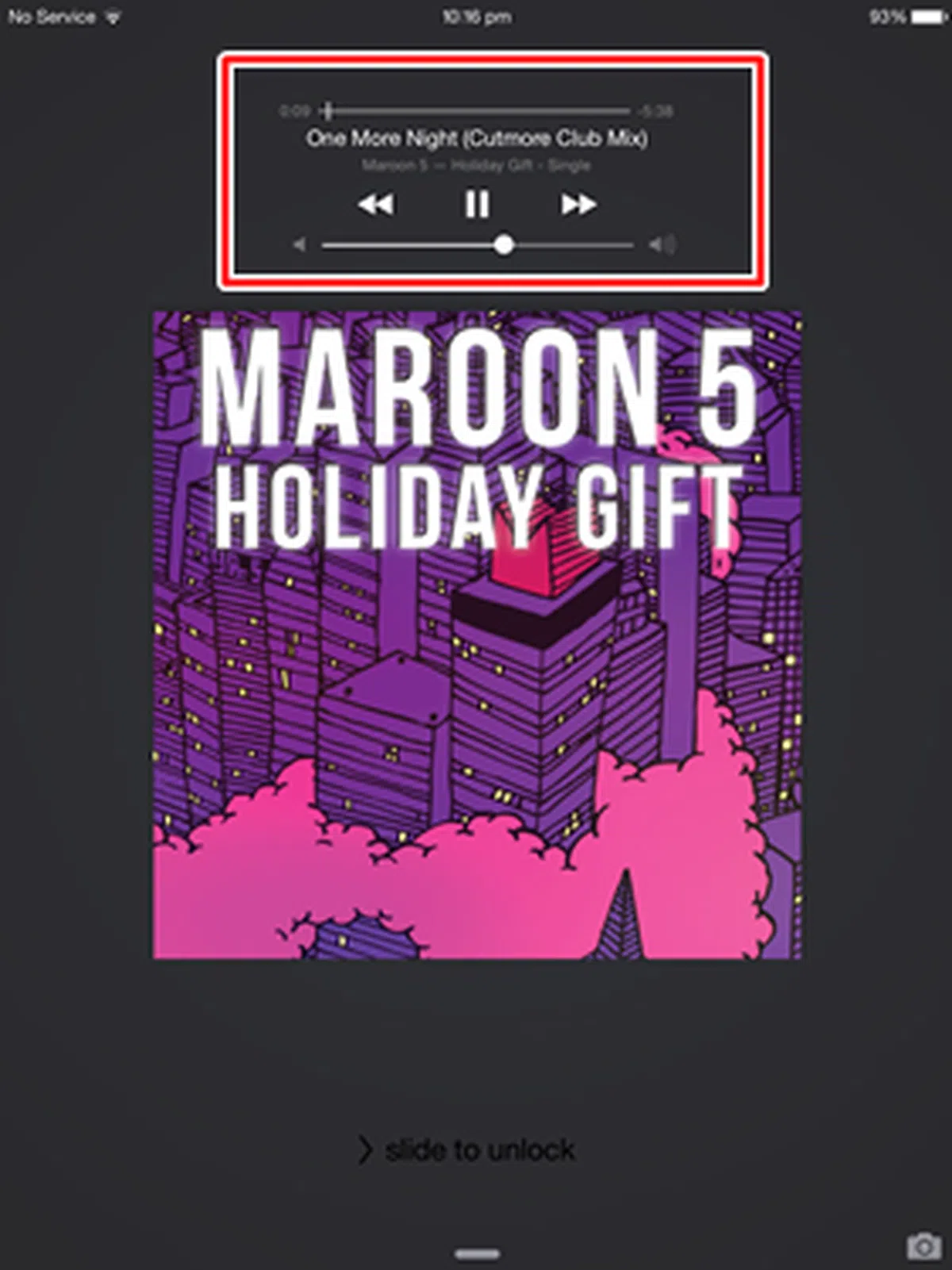 | 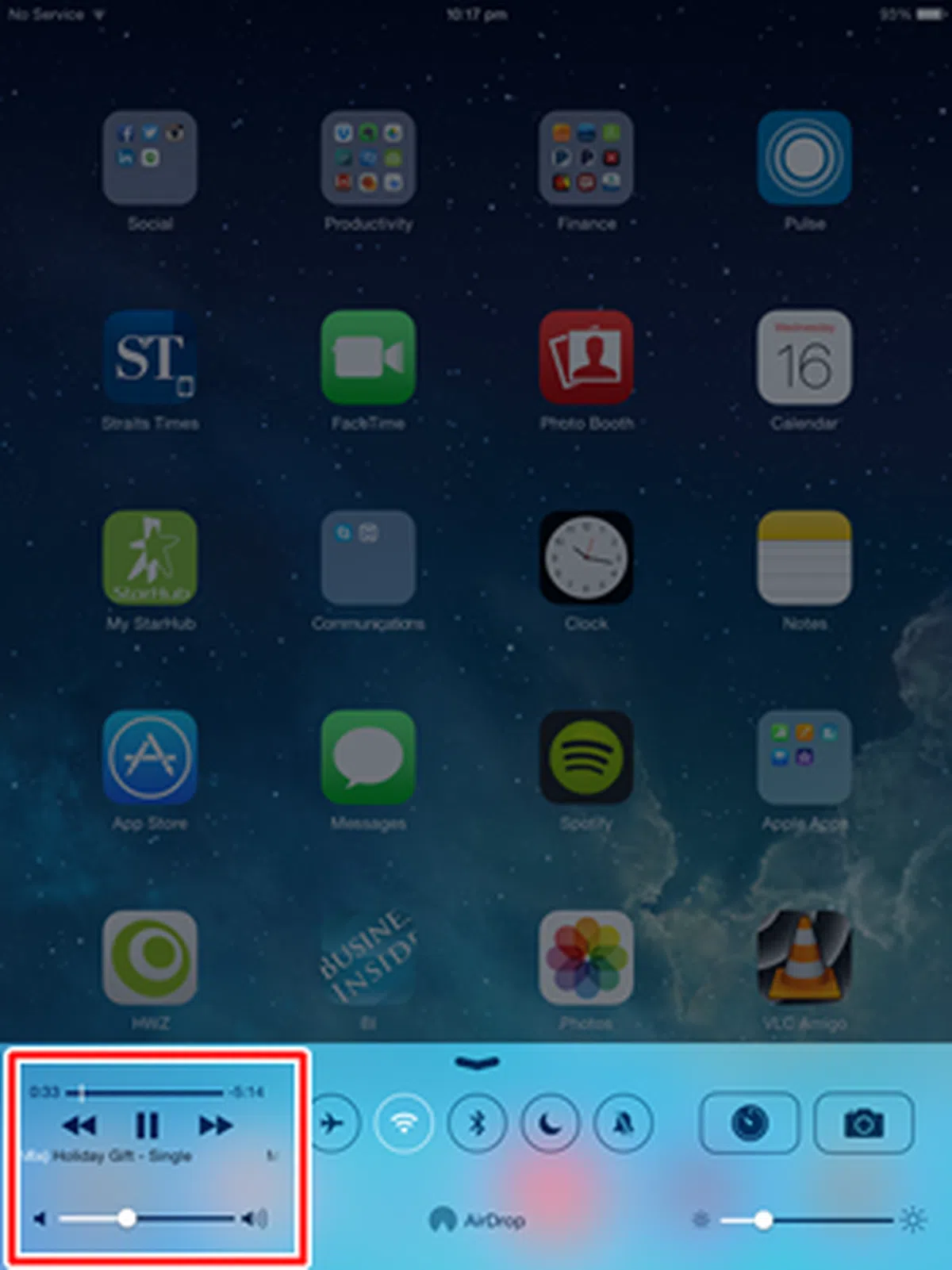 |
Samsung Galaxy Tab S 8.4's Music Player

The default music player on the Galaxy Tab S 8.4 has the tabs located on the top with the music controls at the bottom. Unlike Apple, Samsung has baked in several audio effects (SoundAlive) that you can enable when listening to music. There are two options: basic and advanced.
The basic view offers a balance between Treble, Bass, Vocals and Instrument. You also can toggle with the different audio enhancements such as Tube amp effect, virtual 7.1 channel and studio. The Advanced view provides a seven-band equalizer for you to tune manually and has additional effects like 3D, Bass and Clarity.

When playing music, the controller is shown on the notification panel when you slide down from the top and on the lock screen as a small widget at the bottom left corner of the screen. This makes it easier for you to control the music playback without having to search for the Music app.
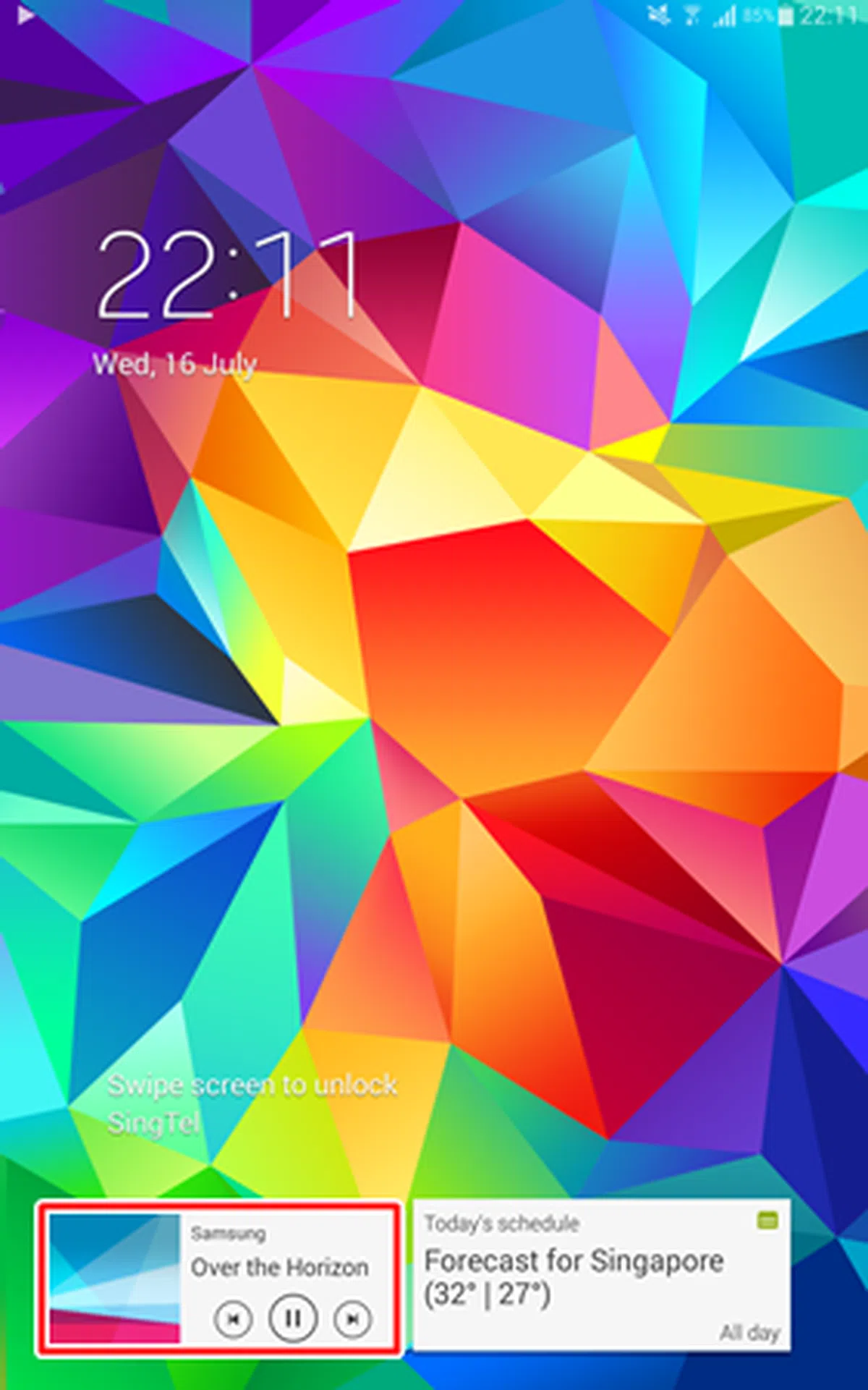 | 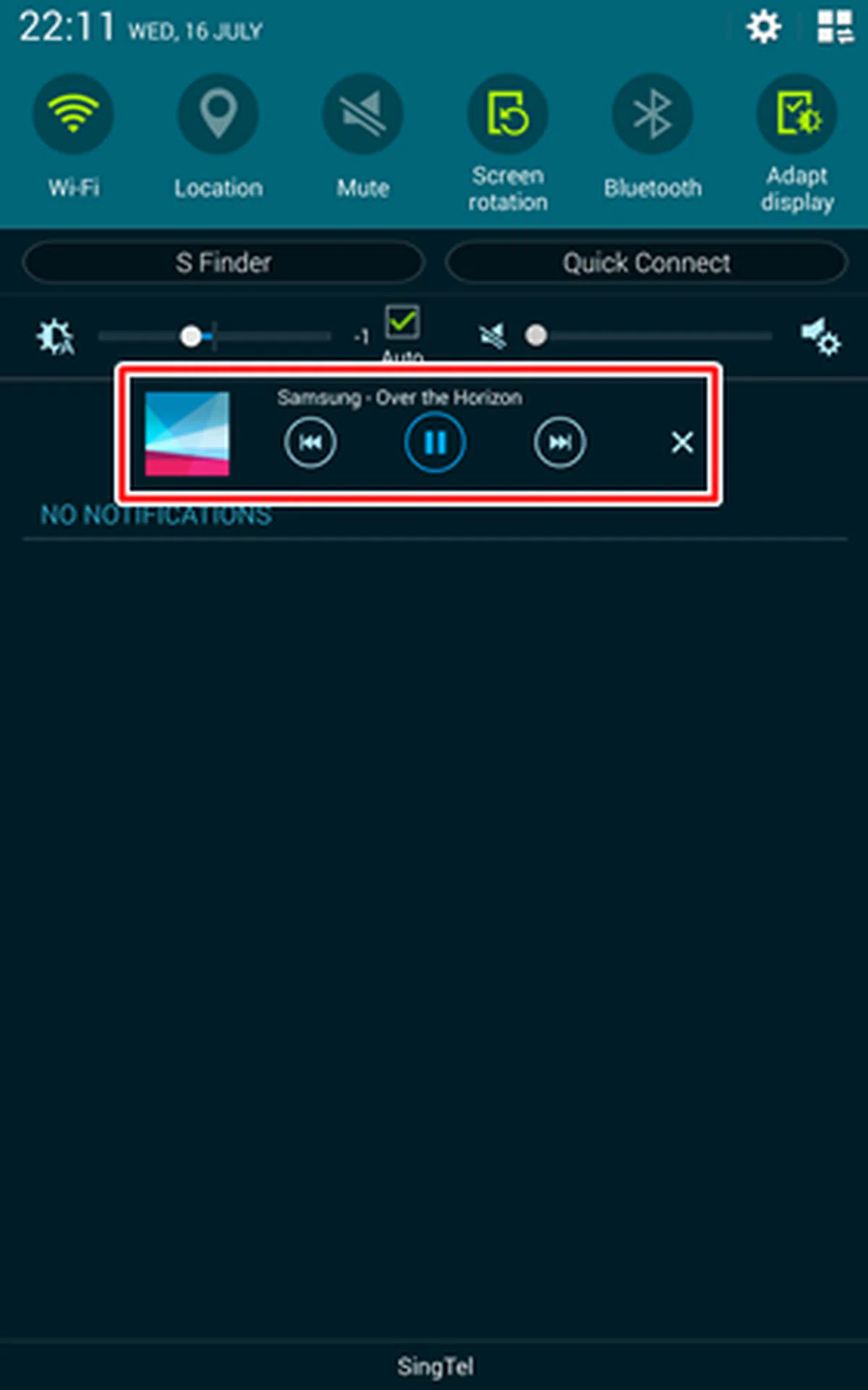 |
LG G Tablet 8.3's Music Player

The music player in the G Tablet 8.3 has the tabs located on the left side (in landscape mode), which makes more sense as you can easily use your left finger to switch between the tabs. The music controls are also situated towards the left at the bottom.
LG preloads five audio effects - pure surround, bass reducer, bass booster, treble booster and vocal booster - in the music player of the G Tablet 8.3. It also includes an option for you to customize the audio effect to your preferences.

Similar to Samsung, LG has the music player widget placed at the upper half of the lock screen and on the notification panel. You have the option to disable the latter by going to Music Player > Menu > Settings > Uncheck the Show Notification option.
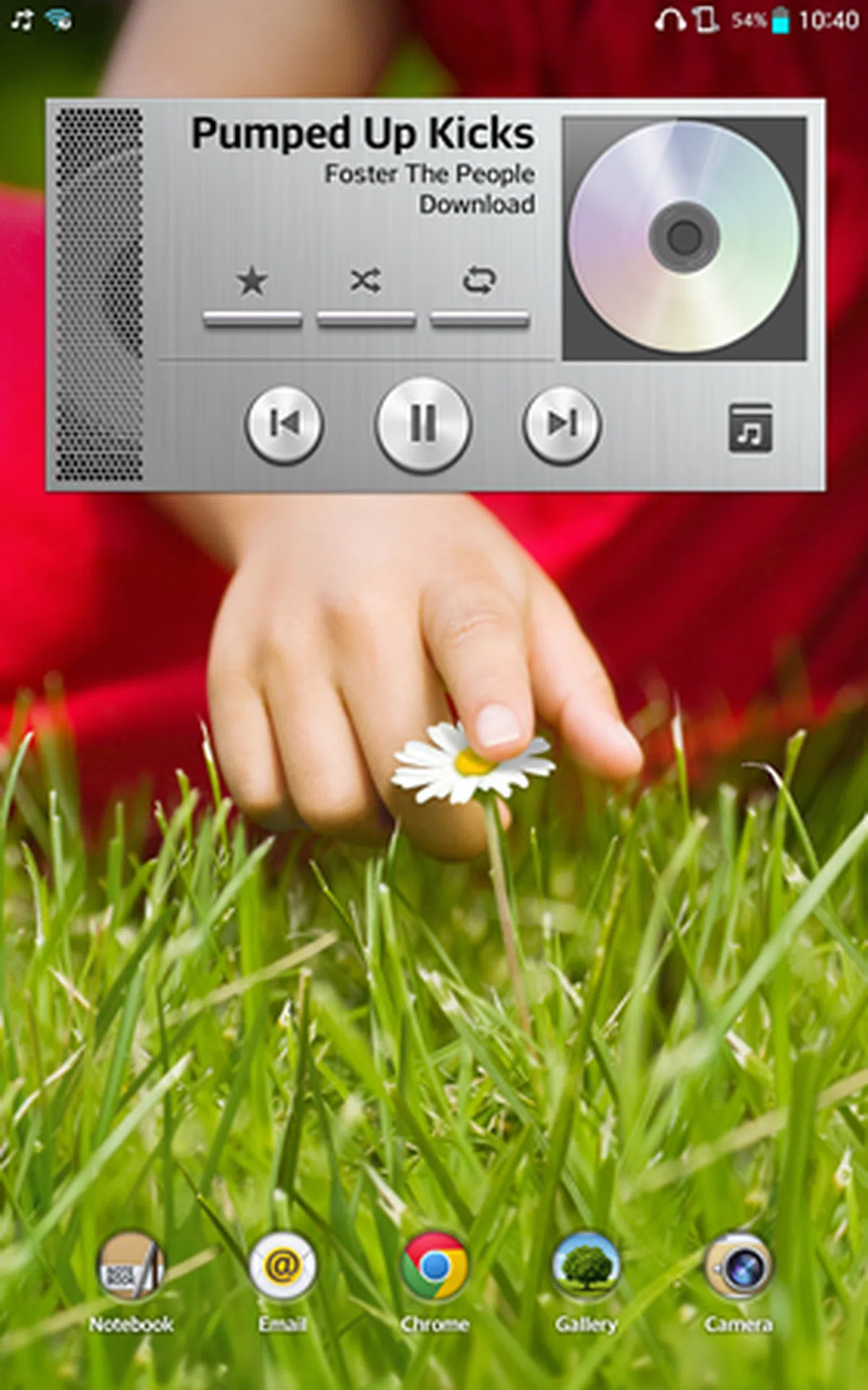 | 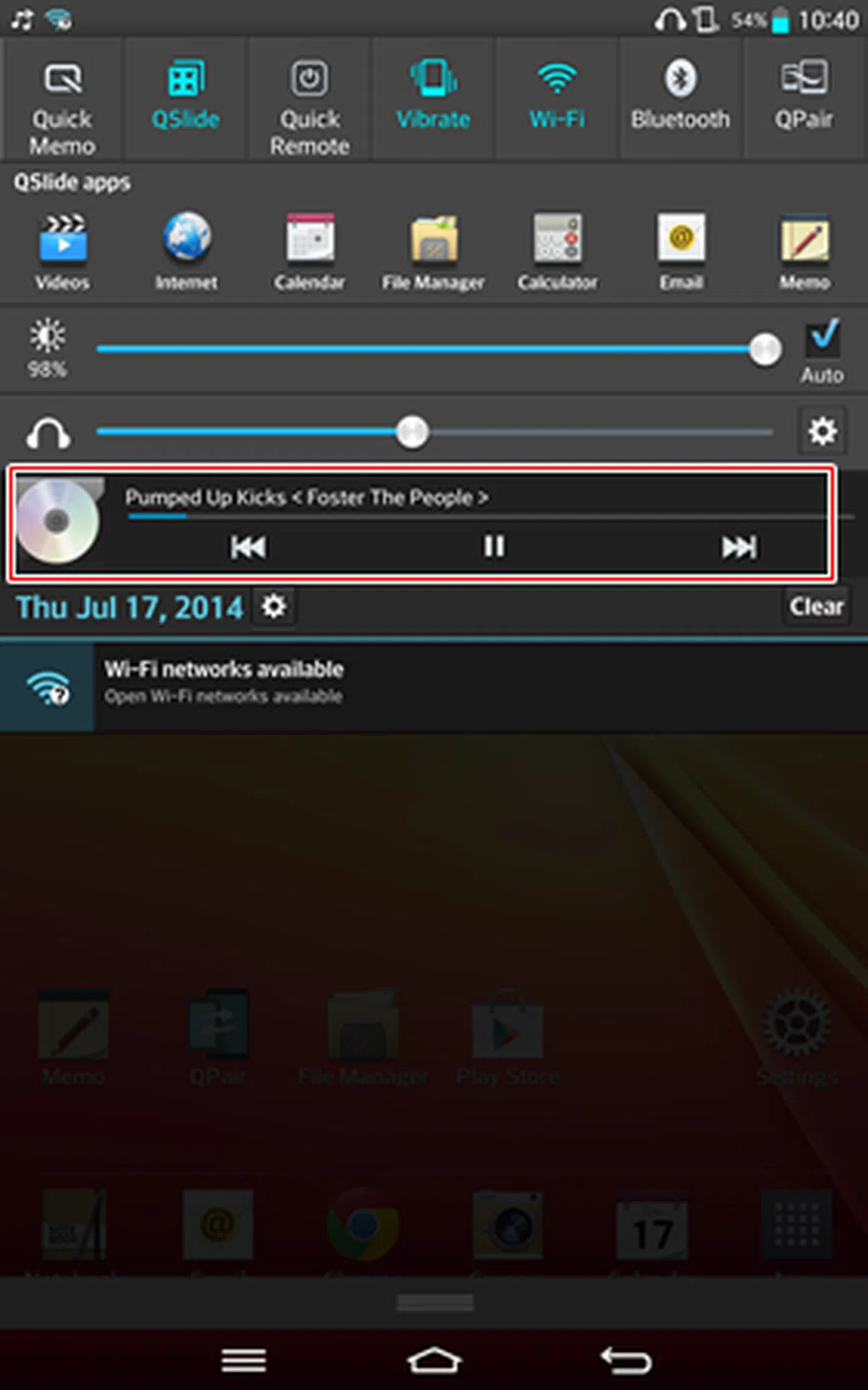 |
Audio Quality through Speakers
While this section doesn't matter if you're going to use headphones/earphones, for those of who plan to use the tablet aloud in your room or elsewhere, you'll probably be interested to know how the built-in speakers fare.
We pushed the volume level to 100% on all three tablets to see the audio output quality. Of the three tablets, we found the Galaxy Tab S 8.4 to be the loudest and clearest. Both stereo speakers are located at the upper portion of either side of the tablet, which is a good placement especially when watching videos in landscape mode. They are unlikely to get muffled by the hands as it is unnatural to hold the tablet on the higher side. The placement could be better if Samsung reverts to the design of the Galaxy Note 10.1 where the speakers are front-facing though.

The stereo speaker on each side of the Samsung Galaxy Tab S 8.4 is not covered when you hold the tablet in landscape mode.
The G Tablet 8.3 lacked both loudness and clarity in its audio output. Its rear-facing speakers are housed along the sides of the tablet, hence it is unlikely you will cover them with your hands. The iPad Mini fared poorly in this comparison as its speakers got muffled by our hands while viewing videos in landscape mode although you can opt to hold the tablet on one side.

While the stereo speakers are not blocked by the hands, audio output is directed away from you on the LG G Tablet 8.3.

As you can see, the only alternative is to hold the Apple iPad Mini in one hand so that the speakers do not get muffled. Clearly the iPad Mini was made for portrait mode usage.
Gaming and Movies
We've gone through in great detail about how the gaming and movie-watching experience will be like in our previous shootout article, hence we'll summarize the key points here.
When it comes to gaming, the iPad Mini takes the upper hand at the moment as it has a larger database of apps, more exclusive partnerships with game developers, and a more comfortable user experience.
The outcome is reversed for movie-watching; both the G Tablet 8.3 and Galaxy Tab S 8.4 have screen aspect ratios of 16:10, which means that you won't be facing the letterboxing issue (two black bars at the top and bottom of the now common widescreen video) that plagues the Apple iPads.

Just like the Samsung Galaxy tablets, the LG G Tablet 8.3 gives you easy access to the brightness control on the left and the volume toggle on the right.
However, between the LG and Samsung tablets, the Galaxy Tab S 8.4 easily gets our nod for its vibrant AMOLED display, which also happens to sip so little power that it can last far longer than any other tablets of its class, thus allowing you to enjoy your movies undisturbed for a lot longer. If the colors are too vibrant, Samsung has a simple control to toggle a suitable preset to appeal to your preferences.
Winner for Reading: Apple iPad Mini with Retina Display
Winner for Music Playback: Apple iPad Mini with Retina Display + Samsung Galaxy Tab S 8.4
Winner for Gaming: Apple iPad Mini with Retina Display
Winner for Movies: Samsung Galaxy Tab S 8.4
Battery Performance
Battery life is still one, if not, the most important criteria for consumers. What's the point of having many features in a tablet that cannot last? Our standard battery test for mobile phones has the following parameters:
- Looping a 720p video with screen brightness and volume at 100%
- Wi-Fi and Bluetooth connectivity turned on
- Constant data streaming through email and Twitter


Despite having the largest battery capacity and smallest display, the iPad Mini did not last the longest; it managed 6 hours and 17 minutes. While it lasted 24% longer than the LG G Tablet 8.3, the Galaxy Tab S 8.4 takes the cake with its record breaking time of 10 hours and 45 minutes. That's more than twice the mileage of the LG tablet and 71% better than the Apple slate!
If we take a look at the Power Consumption chart, the iPad Mini consumed the highest power draw at 3.86W. This is rather surprising as it is not the tablet with the highest pixel density. Ironically, the Galaxy Tab S 8.4 had the lowest power consumption thanks to its power efficient Super AMOLED display.
Portability
With their 8-inch form factor, these tablets are considered very portable compared to their 10-inch counterparts. How do they fare within their own category? Well, our Portability Index can determine that by calculating its battery life to (weight x volume) ratio. Not surprisingly, the Galaxy Tab S 8.4 easily outranked the other two tablets as it has the longest battery life, along with the thinnest and slimmest design. These aspects combined with its light weight propel the Samsung Galaxy Tab S 8.4 to the top of our portability index.

Other Battery Related Matters
Type of Charging Point
The iPad Mini uses Apple's proprietary Lightning port, which means that you have to use the Lightning cable to charge the tablet. It is certainly not as convenient as the LG and Samsung slates, where a micro-USB port is used. While you can use any micro-USB cable to charge the two Android tablets, the rate of charging differs depending on your power source which we've highlighted in this article, "USB Charging for Mobile Devices". However, the main point is that using a standard USB cable means that the Samsung and LG tablets have no shortage of options for charging the device as the connectivity standard is omnipresent.
Power Saving Features
Manufacturers sometimes have to sacrifice on battery capacity to make 8-inch tablets small and light. As a result, battery mileage may not be as good as the 10-inch counterparts. Some tablet makers get around the problem by developing power-saving features. Now, let's take a look at what each tablet has to offer:-
Apple iPad Mini

Apple does not have any power-saving feature(s) on the iPad Mini. It prefers to exercise strict control over the activity of apps running in the background and optimizing the hardware/software aspects to achieve a reasonable level of battery performance. There have been battery draining issues with iOS 7 and we've compiled a list of 7 battery saving tips that you can consider.
Samsung Galaxy Tab S 8.4
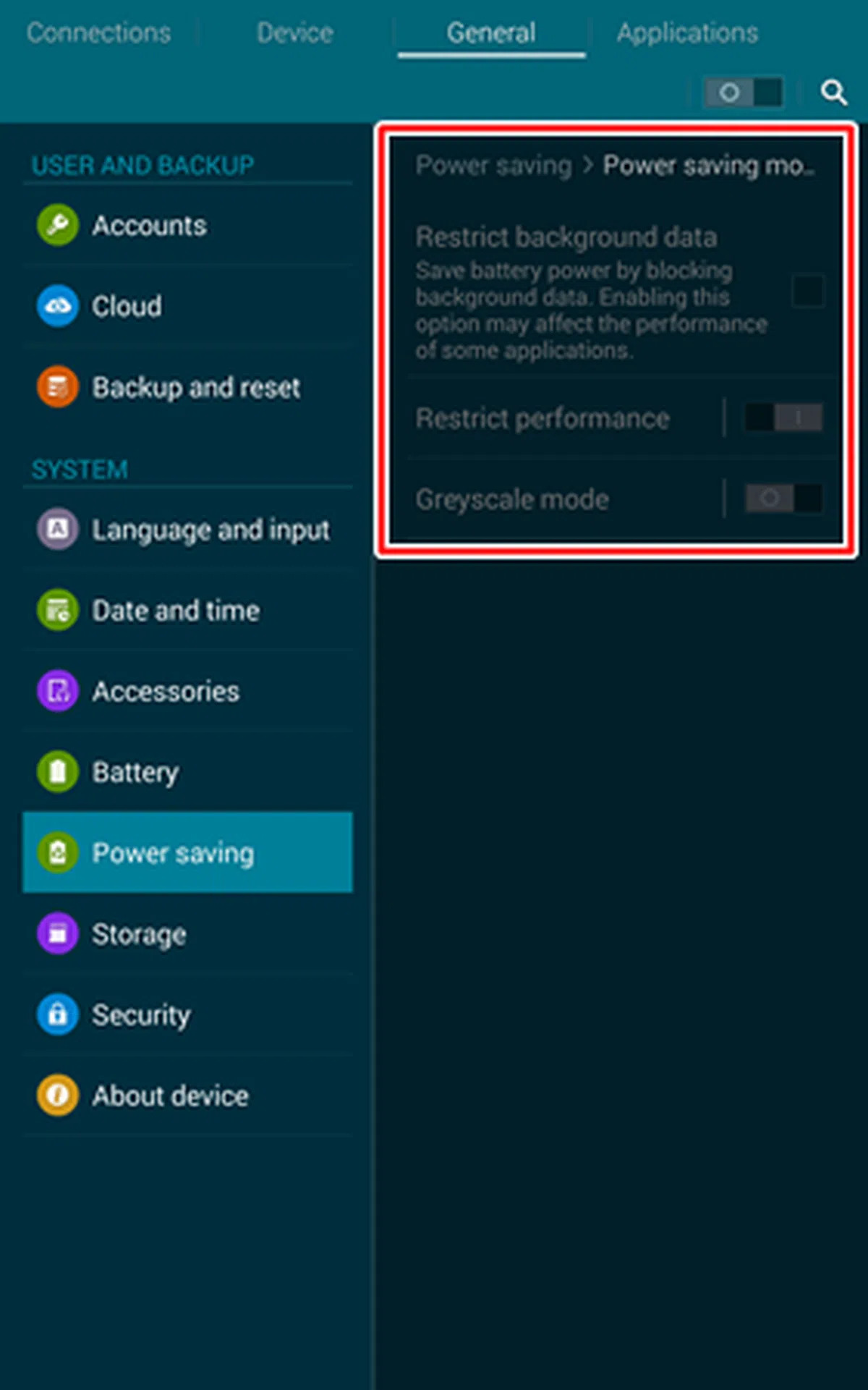 | 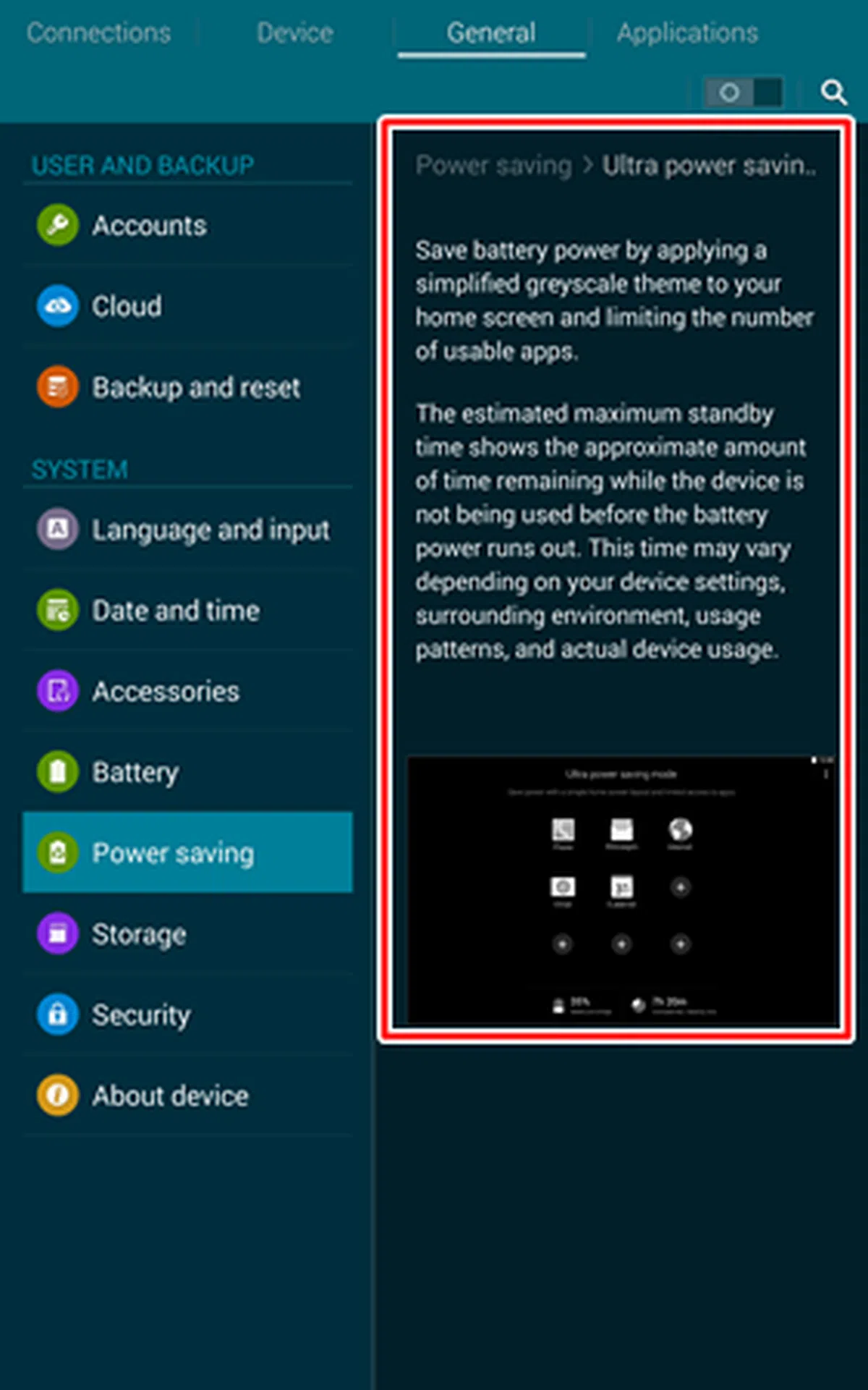 |
Samsung has been an avid user of power saving features for its range of mobile devices. Its most aggressive move is the inclusion of the Ultra Power Saving mode on the Galaxy S5 flagship smartphone, where all unnecessary features such as Bluetooth, Wi-Fi connectivity and camera functionality are disabled. It even switches to a black and white theme for maximum power saving as AMOLED displays do not need to light up pixels to represent black, hence it is easier on the battery.
This feature is also preloaded on the Galaxy Tab S 8.4 alongside the Power Saving mode which limits the maximum performance of the processor, blocks background data access and uses much lower power for the display. Judging from the amazing battery mileage of the Galaxy Tab S 8.4, these two features may hardly be used at all. Also, while it makes sense for a phone to have such aggressive power saving features just so that the person can remain contactable, it probably doesn't matter as much for a tablet because almost all of what's consumed on the tablet is via the internet or apps relying on the internet. There are of course apps that are totally self contained like some games, so that you can entertain your kids for a little longer before required the mandatory charge.
LG G Tablet 8.3

LG has a similar strategy as Samsung; its Battery Saver mode is present in both its smartphones and tablets. You can preset to enable it at 10%, 20%, 30%, 50% of the tablet's remaining power level or even immediately. You also can select the features to be turned off when Battery Saver mode is enabled.
For example, you can determine the screen brightness (10%, 20%, 30% or 50%) and screen timeout (15 seconds, 30 seconds or 1 minute). Touch feedback, Bluetooth and Wi-Fi connectivity can be preset to turn off when the battery is low too.
Winner for Battery Performance: Samsung Galaxy Tab S 8.4
Making Calls
8-inch tablets are considered close relatives of the phablets - devices with screen sizes of at least 5.5-inches - and hence, one shouldn't be surprised if they are used as a primary or secondary device for voice telephony if the feature is supported. Of the three tablets in this comparison, only the Galaxy Tab S 8.4 supports this feature. However, the other two tablets come with somewhat similar features. Let's check them out:
Apple iPad Mini

You can set the number or email address at which you can reached by FaceTime on the iPad Mini.
FaceTime, one of Apple's built-in apps, allows you to make video calls or voice-only-call over a Wi-Fi or cellular connection. If you make a FaceTime call over a Wi-Fi connection, data usage will not be applicable against your data plan. Likewise, FaceTime calls over a cellular network will count against the data plan you have. Do note that video calls typically consume more data than audio calls.
The quality of the call depends on the data connection; a strong Wi-Fi or cellular connection will generally give you a pleasant experience while an unstable connection will result in lags and poorer quality of calls.
Samsung Galaxy Tab S 8.4

Since the introduction of its first tablet (the Galaxy Tab), Samsung has been equipping most of its tablets (models with cellular connection) with voice telephony functions. While we agree that it does look ridiculous to hold up a tablet next to the ear for voice calls, the availability of Bluetooth and wired headsets make it more socially acceptable to be using a tablet as a phone.
The Galaxy Tab S 8.4 (Wi-Fi + 4G LTE) supports such a function with a pre-installed Phone app.The interface looks exactly like that of its smartphones, so Samsung phone users should feel right at home using the Phone app on the tablet. As the call is made over a cellular network, you can expect the quality to be similar to that of a smartphone.
Video calls are also possible on the Galaxy Tab S 8.4 as it has a 2.1-megapixel front-facing camera. However, there is no default app by Samsung to support video calls and you have to download third party apps such as Skype.
The Galaxy Tab S 8.4 also supports an updated version of SideSync, which started off in 2013 a PC-Mobile syncing and file management tool between select Samsung Ativ PCs and Galaxy phones. It has been updated to version 3.0 on the Galaxy Tab S 8.4 where you can accept or reject incoming calls on the tablet if the phone is not within reach. Do note that this call-forwarding function is only supported on the Galaxy Tab S tablets (Wi-Fi only and LTE models), the Galaxy S5 and Note 3 S4 smartphones. Both devices also need to be connected on the same Wi-Fi network. In the absence of a Wi-Fi network, both devices can connect using Wi-Fi Direct.

You can answer or reject an incoming call on the Galaxy Tab S 8.4 (Wi-Fi or LTE) when the "paired" phone is not within reach.

You also can reply text messages from your Galaxy Tab S although this feature is not new.
On a side note, Apple is also introducing a similar feature called Handoff in its upcoming OS X 10.10 Yosemite where you can read, reply, accept and reject text messages or calls from your Mac when your iPhone is not easily accessible. The call-forwarding feature and ability to reply to normal text messages (not iMessage) on the Mac only works with the iPhone though.
LG G Tablet 8.3

The LG G Tablet 8.3 is only available as a Wi-Fi version in Singapore, hence it cannot be used to make cellular calls. While it cannot make calls like a phone, the G Tablet 8.3 can alert you to incoming calls and text messages via LG's QPair app. Available for free on Google Play Store, the QPair app is compatible with LG and other Android devices running Jelly Bean OS. Do note that not all features of the QPair app are supported by all phone models.

When you pair (via Bluetooth) the G Tablet 8.3 with a supported Android smartphone, you can see call notifications on the G Tablet 8.3. You cannot answer the call on the tablet, but you can decline the call with or without a message. It has a front-facing 1.3-megapixel camera, which can make video calls via third party apps such as Google Hangouts.
Data Connectivity
Tablets are used by consumers on the go for productivity tasks and entertainment needs. This is where data connectivity comes into play. In this section, we explore the data connectivity options on the three tablets. The iPad Mini and Galaxy Tab S 8.4 are available in two variants - Wi-Fi only and Wi-Fi + 4G LTE - while the G Tablet 8.3 sold in Singapore only comes as a Wi-Fi model.
In terms of Wi-Fi connectivity, Apple and Samsung claim that their tablets can deliver extremely fast download speeds. The iPad Mini has dual-band (2.4GHz and 5GHz) 802.11n Wi-Fi and MIMO (Multiple Input Multiple Output) technology, which can deliver download speeds of up to 300Mbps.
Similarly, the Galaxy Tab S 8.4 supports dual-band (2.4GHz and 5GHz) 802.11ac Wi-Fi and VHT (Very High Throughput) 80MHz MIMO transmission. It also has a feature, Download Booster, to enhance download speeds by using both Wi-Fi and mobile data concurrently. To find out how Network Booster works and fared in reality, do check out our review of the Galaxy Note Pro 12.2 where we first tested it.
The G Tablet 8.3 also supports Wi-Fi 802.11 a/b/g/n (2.4GHz and 5GHz), but lacks the cellular connectivity option and enhanced speed booster features found in the other two tablets.
When it comes to 4G LTE connectivity, the iPad Mini sold in Singapore supports 14 LTE bands (two of which are used by all three telcos). In comparison, the Galaxy Tab S 8.4 only supports six LTE bands (2600, 2100, 1800, 900, 850, 800MHz). What this means is that the iPad Mini can connect to more LTE networks around the world. For consumers who often travel overseas, this is a major plus point.
Supporting more bands is one part of the big picture; the speeds supported is another. The Galaxy Tab S 8.4 supports LTE Cat 4, which means you can enjoy download speeds of up to 150Mbps. The iPad Mini supports LTE Cat 3; the maximum download speed is 100Mbps.
Winner for Making Call: Samsung Galaxy Tab S 8.4
Winner for Data Connectivity: Apple iPad Mini with Retina Display + Samsung Galaxy Tab S 8.4
Conclusion
Apple iPad Mini with Retina Display (LTE) | LG G Tablet 8.3 (Wi-Fi only) | Samsung Galaxy Tab S 8.4 (LTE) | Winner | |
Reading |
|
|
| |
Music |
|
|
| |
Games |
|
|
| |
Movies |
|
|
| |
Calls |
|
|
| |
Data Connectivity |
|
|
| |
Battery Performance |
|
|
| |
Final Tally | N.A. |
With a final tally of five wins, the Samsung Galaxy Tab S 8.4 emerged the winner in this shootout. In terms of multimedia consumption on the go, it has a solid edge over the other two tablets thanks to its amazing battery life, super slim and light design, a dazzling display and great audio output from its speakers. Its data connectivity support and telephony function also ensures you are kept connected anywhere you go. The Apple iPad Mini with Retina Display has a tie with the Galaxy Tab S 8.4 in terms of data connectivity and listening to music. This is because it supports more 4G LTE bands and has an excellent music store. It also remains the best tablet for reading. Despite the clear win for Samsung, the results of this shootout do not apply to everyone; people have different needs and certain aspects are more important than others. At the end of the day, you'll have to decide which tablet fits your needs better. For a more in-depth look at each tablet, as well as full imaging performance and benchmark analysis, do refer to each tablet's individual reviews:
| ||
Our articles may contain affiliate links. If you buy through these links, we may earn a small commission.
